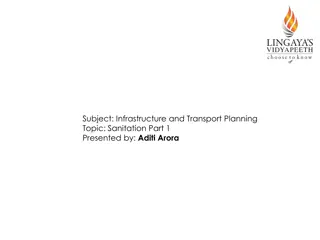Comprehensive Overview of Sewage Treatment Plant Processes and Energy Generation
This seminar presentation dives deep into the world of sewage treatment plants, covering definitions, introduction, STP treatment stages (including primary, secondary, and tertiary treatments), energy generation through microbial fuel cells, and biogas generation. It emphasizes the importance of treating sewage before disposal, discusses the removal of organic and inorganic wastes, and explores various processes like grit removal, biological treatment, and advanced treatment methods. The focus on energy generation from agricultural waste, manure, and domestic waste showcases sustainable practices in wastewater management.
Download Presentation

Please find below an Image/Link to download the presentation.
The content on the website is provided AS IS for your information and personal use only. It may not be sold, licensed, or shared on other websites without obtaining consent from the author. Download presentation by click this link. If you encounter any issues during the download, it is possible that the publisher has removed the file from their server.
E N D
Presentation Transcript
SeminarPpt.com Seminar on Sewage Treatment Plant Submitted to: Seminarppt.com Submitted By Seminarppt.com
Table Contents Definition Introduction STP Treatment Energy Generation Conclusion 2
Definition Sewage is the waste generated from residential, institutional, commercial and industrial establishments. 3
Introduction STP plant treats the sewage to make it fit for safe disposal, agricultural use or domestic use in toilets etc. Sewage usually contains a high quantity of organic and inorganic wastes. It is essential to treat sewage before it enters into any water body. 4
STP TREATMENT Primary Treatment In Primary treatment, wastewater is fed to a screen to remove all large objects that are suspended in the water. After this, the water gets into a Grit chamber where the grit is removed. Grit removal is necessary to reduce heavy deposits in aeration tanks, digester, channels, and conduits. 6
STP TREATMENT Secondary Treatment Secondary treatment is the second stage of wastewater treatment. In primary treatment, suspended solids, colloidal particles, oil, and grease are removed. Then second biological treatment is done on the wastewater to remove the organic matter present. 7
STP TREATMENT Tertiary Treatment Tertiary treatment is the third stage of the wastewater treatment and is also known as an advanced treatment. Tertiary treatment removes the load of nitrogen and phosphorus present in the water. It includes processes like filtration, ion exchange, activated carbon adsorption, electrodialysis, nitrification, and denitrification. 8
Energy generation Microorganisms which are involved in the production of energy are called microbial fuel cells. Microbial fuel cells are used to generate a variety of energy sources like biogas and electricity. Agricultural waste, manure, and domestic wastes are used as raw materials for the generation of biogas. 9
Energy generation Biogas generation is done in the large concrete tank which is called a biogas plant. Biomasses (Biowastes) are collected at the biogas plant and the slurry is fed. Biomasses are rich in organic matter. Some of the bacteria can grow anaerobically inside the biogas plant. These bacteria can digest the biomasses which are present in the slurry and sewage. 10
Energy generation During digestion, a huge amount of mixture of gases is released inside the tank. The mixture of these gases is called the biogas. Biogas is removed from the biogas plant through a separate outlet. Microbial fuel cells are also used to generate electricity from wastewater. 11
Energy generation Microbial fuel cells utilize the organic matter from the wastewater treatment plant. During digestion, organic matters are converted into the simple molecule and release the carbon dioxide and electrons. Those electrons are absorbed by the electrode and used as the source of electricity. 12
Conclusion As sewage enters a plant for treatment, it flows through a screen, which removes large floating objects such as rags and sticks that might clog pipes or damage equipment. After sewage has been screened, it passes into a grit chamber, where cinders, sand, and small stones settle to the bottom. 13
References Wikipedia.org Google.com Seminarppt.com Studymafia.org























